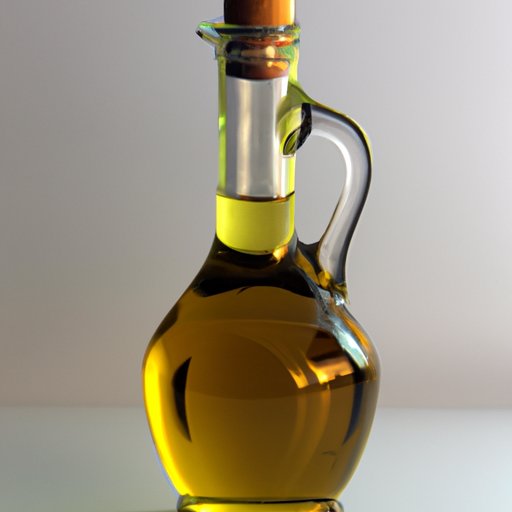
Introduction
Olive oil has become increasingly popular in recent years, with many chefs and home cooks using it for everything from salad dressings to marinades. However, there is still a common problem of people wondering whether olive oil is suitable for cooking, or whether it is only meant to be used raw. In this article, we will explore the different types of olive oil, their properties, and their suitability for various cooking methods, as well as provide some tips and recipes to help you get started.
Understanding Olive Oil and Cooking
Olive oil is produced by pressing olives and extracting their oil. There are several different types of olive oil, including extra-virgin, virgin, refined, and pure.
Extra-virgin olive oil is considered the highest quality and is made from pure, cold-pressed olives. It has a fruity flavor and is ideal for use in dishes that require a robust olive flavor, such as salad dressings or dips.
Virgin olive oil is also made from pure, cold-pressed olives but has a slightly less intense flavor than extra-virgin olive oil. It is still suitable for cooking and is a great substitute for extra-virgin olive oil if you are looking for a milder taste.
Refined olive oil is made from a blend of cold-pressed and processed oils. It has a neutral flavor and a higher smoke point, making it a good choice for cooking at high temperatures.
Pure olive oil is a blend of refined and virgin olive oils and is not as high quality as extra-virgin or virgin olive oil. It is still suitable for cooking and has a milder flavor than extra-virgin olive oil.
The smoke point of olive oil, or the temperature at which the oil begins to smoke and break down, varies depending on the type of olive oil. Extra-virgin olive oil has a lower smoke point and is best used for low-heat cooking or as a finishing oil. Virgin and pure olive oil have a higher smoke point and can be used for sautéing or frying.
How to Cook with Olive Oil: A Beginner’s Guide
Cooking with olive oil is easy and can add flavor and nutrition to your dishes. Here is a step-by-step guide on how to use olive oil for cooking:
- Choose the right type of olive oil for your dish.
- Heat the olive oil in a pan over medium heat.
- Add your desired ingredients and cook as usual, adjusting the heat as needed.
- Monitor the oil to ensure it doesn’t smoke or burn.
- Use a slotted spoon or spatula to remove any excess oil before serving.
When cooking with olive oil, it is essential to pay attention to temperature and cooking duration to avoid burning the oil. Olive oil adds flavor to your dishes and offers several health benefits, including aiding in digestion and providing healthy fats.
Recipes Featuring Olive Oil
If you need some inspiration for incorporating olive oil into your dishes, here are a few recipe ideas:
- Roasted vegetables tossed in extra-virgin olive oil and seasoned with salt and pepper
- Sautéed chicken breasts cooked in virgin olive oil and seasoned with garlic and herbs
- A homemade vinaigrette made with extra-virgin olive oil, balsamic vinegar, honey, and Dijon mustard
- Pasta tossed in pure olive oil and garlic, topped with fresh herbs and parmesan cheese
These dishes highlight the versatility of olive oil in cooking and can be easily customized to your preferences.
The Health Benefits and Potential Drawbacks of Using Olive Oil in Cooking
Incorporating olive oil into your diet offers several health benefits, including reducing inflammation, lowering cholesterol levels, and providing antioxidants. However, it is essential to note that consuming too much olive oil can lead to weight gain and other health risks.
To balance the use of olive oil in your diet, it is recommended to use it in moderation and opt for other healthy fats, such as nuts or avocados. Additionally, choose high-quality olive oils and avoid processed foods that contain lower quality oils.
The Historical Significance of Cooking with Olive Oil
Olive oil has a rich history in Mediterranean cuisine and ancient civilizations, dating back to ancient Greece and Rome. It was considered a luxury item and was often used for religious ceremonies and healing purposes.
Today, olive oil is still a staple ingredient in Mediterranean and other cuisines and is celebrated for its versatility and flavor.
Debunking Common Myths and Misconceptions
There are several myths and misconceptions surrounding the use of olive oil in cooking, including that it is only meant to be used raw or that it cannot be heated without losing its health benefits.
However, these statements are not entirely accurate. Olive oil can be used for both raw and cooked foods, depending on the type of olive oil and the desired flavor. Additionally, olive oil’s health benefits are not significantly impacted by cooking, as long as it is not overheated or overused.
Conclusion
In conclusion, cooking with olive oil is a great way to add flavor and nutrition to your dishes, as long as you choose the right type of olive oil for your cooking needs. Whether you are sautéing chicken or making a homemade salad dressing, olive oil can be a versatile and delicious ingredient for enhancing your culinary creations.
Remember to use olive oil in moderation, balance it with other healthy fats, and choose high-quality oils to reap the most significant health benefits and flavor.




